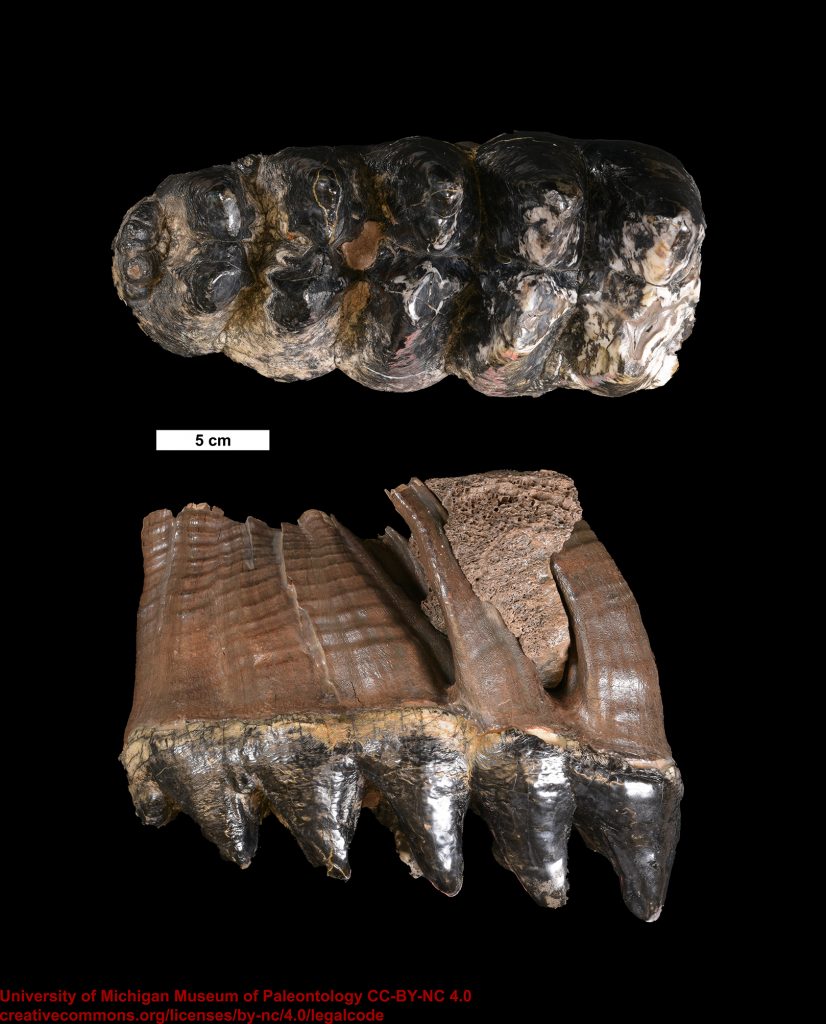
Bones and Teeth
Vertebrate fossils are relatively rare in Michigan and can range from fragments of the plates of prehistoric armored fish preserved in Devonian rocks to nearly complete skeletons of mastodons and mammoths in the wet, sticky, marl (carbonate rich mud) of the Pleistocene.
This is a broad category, and it is much more common to find bones and teeth from modern animals than to find fossil bones. This section includes tips on determining if what you have found is, in fact, a fossil. Below these identification tips are tips for identifying a couple of iconic Michigan fossils: mastodon and mammoth teeth.

Tip #1 Color can be deceptive. It’s amazing what dirt and grime can do to the color of bones. Just because something is heavily stained doesn’t mean it’s been there for thousands of years, and some fossil bones look as though they are brand new. Environmental factors make coloration of bone not a particularly useful indicator of its age.
Tip #2 Context. In Michigan, Pleistocene bones and teeth are found in loose sediment like marl or sometimes sand, but not in rock like limestone or shale. Older fossils, like placoderm plates, are found in consolidated rock, although that rock might be just a small loose cobble.
Tip #3 Soft parts. Soft parts (skin, hair, organs, horns, claws, etc.) of vertebrate animals are usually not preserved as fossils in Michigan.
If you have found what might be fossil bones or teeth in Michigan and would like help identifying them, please contact us by email and send along several photos of your find with a ruler or coin (for a scale reference).
American Mastodon Teeth VS Mammoth Teeth
American mastodon (Mammut americanum)
In Michigan, mastodon fossils are only preserved in Pleistocene sediments. Most mastodon fossils in Michigan are around 12,000 years old.
Michigan’s State Fossil
The crown of a mastodon tooth consists of a series of prominent ridges and valleys covered with enamel that may be several millimeters thick. The enamel may be dark, as in the photo below, but it may also be white. The roots and any exposed dentin (dentin underlies the enamel) are usually brown. The tooth in the image is a third molar, which is the largest of the teeth (well, except for the tusks!).
Identification Tips
1. Large, cuspate teeth (have peaks and valleys like our molars do)
2. Crown covered with a thick enamel layer
See a 3D model of a mastodon tooth
Interested in seeing the tooth in the skull? Check out this 3D mastodon skull. Or go a step further and explore a complete mounted skeleton in 3D.

Mammoth (Mammuthus)
In Michigan, mammoth fossils are only preserved in Pleistocene sediments. Most mammoth fossils in Michigan are around 12,000 years old.
The chewing surface of a mammoth tooth consists of a series of many flattened enamel loops, with dentin inside the loops and cementum between them. The surface resembles a washboard. At a fine scale, the paths of the enamel loops zigzag slightly. Mammoth teeth look very similar to the teeth of modern Asian elephants.
Identification Tips
1. Flat chewing surface with a distinctive washboard pattern
2. No large cusps
See a 3D model of a mammoth tooth.
Interested in seeing the tooth in the skull? Check out this 3D mammoth skull or this 3D mammoth lower jaw.



